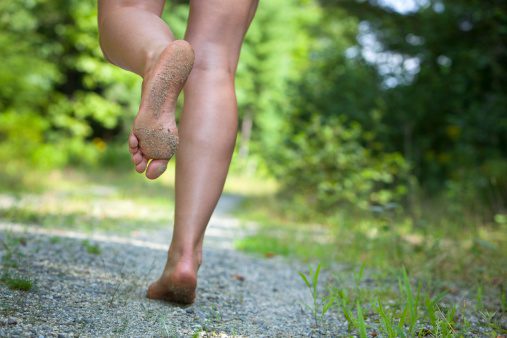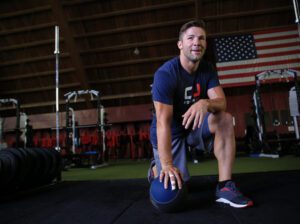Barefoot running has become a popular trend in recent years, infusing the market with many options for barefoot and minimal footwear. While running in these shoes may seem exciting and interesting, they also increase the workload that the body is used to doing, and force the body to stabilize and support itself in new ways. Inadequate strength and stability open the door for injuries to occur. Use these tests to assess whether or not you’re ready for a minimal ride.
Hip Stability
The gluteal muscles are more than just the powerful gluteus maximus. The gluteus minimus and gluteus medius are both responsible for pelvic stability and ensuring that the pelvis does not rotate while running. When these muscles are weak, a lack of hip stability will cause excess movement at the knee and foot, opening the door for injury. These issues become more exacerbated with minimal shoes  Test: Single Leg Squat Perform a front elbow plank with good posture, thinking about pulling the belly button away from the floor and slightly engaging the glutes. You should be able to slightly lift one foot on each side without any rotation in the pelvis.
Test: Single Leg Squat Perform a front elbow plank with good posture, thinking about pulling the belly button away from the floor and slightly engaging the glutes. You should be able to slightly lift one foot on each side without any rotation in the pelvis.
Intrinsic Foot Strength
The many small muscles of the foot help support the arch, grip, and push during toe off. Adequate strength and flexibility in the foot is key, especially when running in minimal shoes. Without the strength to support the foot, those muscles will become stressed and will be susceptible to injury.
Test: Toe Yoga Standing barefoot, raise your big toe while keeping all other 4 toes on the floor. Then, put your big toe down and raise the other 4 toes without moving the big toe. You should be able to do this without having to compensate by rotating the foot or moving your lower legs. 

Calf Range of Motion
Traditional running shoes tend to provide 10-12mm of foam under your foot. When you remove this, the calf muscles have to pick up the slack. Their range of motion is now required to make up for the 10-12mm that used to be a shoe underfoot. Without full range of motion, and the strength to support the body through this range of motion, the calves will be set up for potential injury.


Test: Heel Raise and Lower: Standing on a stair, scoot your foot to the edge so you’re balancing on the ball of your foot. Raise up to your toes, pause, then lower all the way down so that your heels are below the stair. Then, raise up to your toes from the lowered position before bringing back down. This exercise tests the calf’s ability to support your body weight through its full range of motion. If this is difficult to do, or you need to hold on to the rail for a lot of support, consider strengthening your calves before running in minimal shoes. If these exercises are difficult, then those are red flags that there are weaknesses in the body that should be corrected before increasing their workload through minimal running. Use these exercises to strengthen each area, progressing to 2-3 sets of 10-12 reps before considering running in minimal shoes.
Allow for Adaptation
Like any new stimulus, there needs to be time for adaptation. Begin slowly, adding in some short, easy runs and focusing on strengthening the body to prepare for the new stress of minimal running. Take extra care to stretch and work on flexibility. Don’t just jump in and start 100% of your runs with minimal shoes. Adapt slowly and focus on enhancing strength and flexibility along the way to avoid setting yourself up for injury. When in doubt, touch base with a running coach to cover off on barefoot running technique and these tests.
How useful was this post?
Click on a star to rate it!
Average rating 5 / 5. Vote count: 2
No votes so far! Be the first to rate this post.



